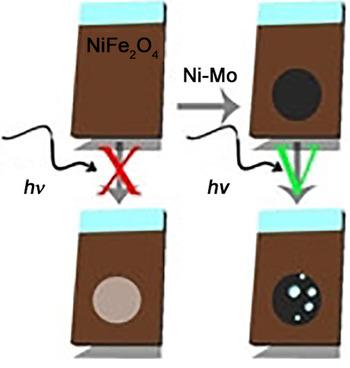当前位置:
X-MOL 学术
›
ChemSusChem
›
论文详情
Our official English website, www.x-mol.net, welcomes your
feedback! (Note: you will need to create a separate account there.)
Cathodic Electrodeposition of Ni−Mo on Semiconducting NiFe2O4 for Photoelectrochemical Hydrogen Evolution in Alkaline Media
ChemSusChem ( IF 7.5 ) Pub Date : 2018-03-23 , DOI: 10.1002/cssc.201800112 Jochem H. J. Wijten 1 , Ronald P. H. Jong 2 , Guido Mul 2 , Bert M. Weckhuysen 1
ChemSusChem ( IF 7.5 ) Pub Date : 2018-03-23 , DOI: 10.1002/cssc.201800112 Jochem H. J. Wijten 1 , Ronald P. H. Jong 2 , Guido Mul 2 , Bert M. Weckhuysen 1
Affiliation

|
Photocathodes for hydrogen evolution from water were made by electrodeposition of Ni−Mo layers on NiFe2O4 substrates, deposited by spin coating on F:SnO2‐glass. Analysis confirmed the formation of two separate layers, without significant reduction of NiFe2O4. Bare NiFe2O4 was found to be unstable under alkaline conditions during (photo)electrochemistry. To improve the stability significantly, the deposition of a bifunctional Ni−Mo layer through a facile electrodeposition process was performed and the composite electrodes showed stable operation for at least 1 h. Moreover, photocurrents up to −2.1 mA cm−2 at −0.3 V vs. RHE were obtained for Ni−Mo/NiFe2O4 under ambient conditions, showing that the new combination functions as both a stabilizing and catalytic layer for the photoelectrochemical evolution of hydrogen. The photoelectrochemical response of these composite electrodes decreased with increasing NiFe2O4 layer thickness. Transient absorption spectroscopy showed that the lifetime of excited states is short and on the ns timescale. An increase in lifetime was observed for NiFe2O4 of large layer thickness, likely explained by decreasing the defect density in the primary layer(s), as a result of repetitive annealing at elevated temperature. The photoelectrochemical and transient absorption spectroscopy results indicated that a short charge carrier lifetime limits the performance of Ni−Mo/NiFe2O4 photocathodes.
中文翻译:

Ni-Mo2O4上的Ni-Mo阴极电沉积在碱性介质中光电化学氢的释放
通过将Ni-Mo层电沉积在NiFe 2 O 4基底上,并通过旋涂将其沉积在F:SnO 2玻璃上,制成了从水中析出氢的光电阴极。分析证实了形成两个分开的层,而没有显着还原NiFe 2 O 4。发现在(光)电化学过程中碱性条件下裸NiFe 2 O 4不稳定。为了显着提高稳定性,通过便捷的电沉积工艺进行了双功能Ni-Mo层的沉积,复合电极显示了至少1小时的稳定运行。此外,光电流高达-2.1 mA cm -2在环境条件下,Ni-Mo / NiFe 2 O 4在-0.3 V vs. RHE下获得了氢,表明该新组合既充当氢的光电化学放出的稳定层又充当催化层。这些复合电极的光电化学响应随NiFe 2 O 4层厚度的增加而降低。瞬态吸收光谱表明,激发态的寿命短且在ns时标上。观察到NiFe 2 O 4的寿命增加由于在高温下进行了重复退火,因此可以通过减小一次层中的缺陷密度来解释大层厚度的变化。光电化学和瞬态吸收光谱结果表明,短的载流子寿命限制了Ni-Mo / NiFe 2 O 4光电阴极的性能。
更新日期:2018-03-23
中文翻译:

Ni-Mo2O4上的Ni-Mo阴极电沉积在碱性介质中光电化学氢的释放
通过将Ni-Mo层电沉积在NiFe 2 O 4基底上,并通过旋涂将其沉积在F:SnO 2玻璃上,制成了从水中析出氢的光电阴极。分析证实了形成两个分开的层,而没有显着还原NiFe 2 O 4。发现在(光)电化学过程中碱性条件下裸NiFe 2 O 4不稳定。为了显着提高稳定性,通过便捷的电沉积工艺进行了双功能Ni-Mo层的沉积,复合电极显示了至少1小时的稳定运行。此外,光电流高达-2.1 mA cm -2在环境条件下,Ni-Mo / NiFe 2 O 4在-0.3 V vs. RHE下获得了氢,表明该新组合既充当氢的光电化学放出的稳定层又充当催化层。这些复合电极的光电化学响应随NiFe 2 O 4层厚度的增加而降低。瞬态吸收光谱表明,激发态的寿命短且在ns时标上。观察到NiFe 2 O 4的寿命增加由于在高温下进行了重复退火,因此可以通过减小一次层中的缺陷密度来解释大层厚度的变化。光电化学和瞬态吸收光谱结果表明,短的载流子寿命限制了Ni-Mo / NiFe 2 O 4光电阴极的性能。











































 京公网安备 11010802027423号
京公网安备 11010802027423号